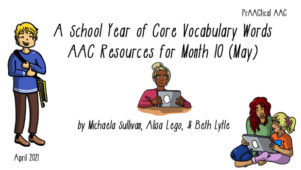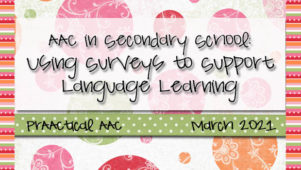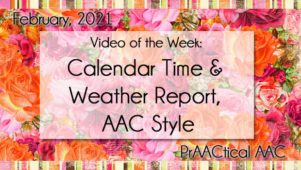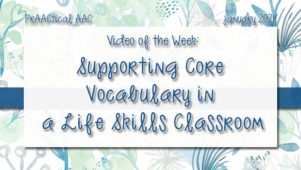AAC in Secondary School: Defining Age Respectful
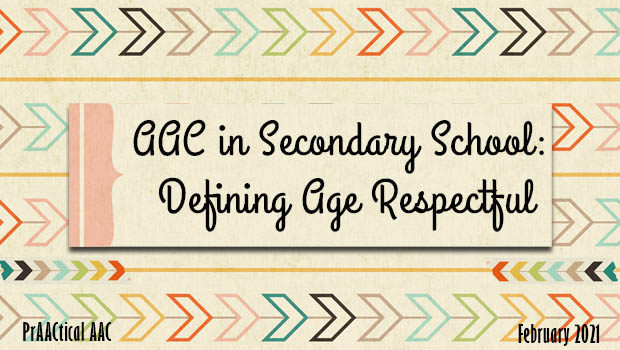
 Today, we welcome back AAC SLP Ashley Larisey to these pages for another post in the AAC in Secondary School series. Ashley is an SLP at Community High School District 218 in Oak Lawn, Illinois. She is also an Adjunct Clinical Supervisor and Instructor at Saint Xavier University.
Today, we welcome back AAC SLP Ashley Larisey to these pages for another post in the AAC in Secondary School series. Ashley is an SLP at Community High School District 218 in Oak Lawn, Illinois. She is also an Adjunct Clinical Supervisor and Instructor at Saint Xavier University.
In today’s post, she shares thoughts on being age-respectful in choosing content, activities, and materials for high school students who are learning to use AAC.
::::::::::::::::::::::::::::::::::::::::::::::::::::::::::::::::::::::::::::::::::::::::::::::::::::::::::::::::::::::
Defining Age-Respectful
The terms “age-appropriate” and “functional” are terms that come up frequently when working with older learners with complex communication needs and/or significant cognitive impairments. These students are entitled to receive an education that is aligned with the grade level standards in their state. Instruction should respect that these learners are no longer children, but in fact teenagers or young adults.
But what do the terms “age-appropriate” and “functional” really mean? How are those terms intertwined with the goal of providing rigorous instruction to all students that presumes their potential to learn and become independent, autonomous communicators? What characteristics make our therapy or instruction “age-appropriate” and/or “functional?”
These are all very valid questions, but there is a lot to unpack with this topic. Let’s start by defining some terms that will be used within this blog post.
Definitions:
Age-appropriate: suitable for a particular age or age group.
Functional: designed to be practical and useful.
Rigor: instruction, schoolwork, learning experiences, and educational expectations that are academically, intellectually, and personally challenging.
(Source: Oxford Languages)
One of the biggest complaints about use of the term “age-appropriate” is the word appropriate. It is a subjective term, and therefore difficult to define. How does one determine what age range an activity, interest, or material is “appropriate” for?
The word “functional” is also often misunderstood, as it is frequently used synonymously with activities of daily living, like sorting laundry or grocery shopping. Activities of daily living can be functional, but they certainly are not the only activities that are practical and useful.
Before we dive in, I think it is critical to make the distinction between student interests and curriculum and instruction for the purposes of determining what is or isn’t age-appropriate.
When we are working with older learners, it is important not to assume that their interests match their communication profiles. Some of my most emergent communicators have interests that are shared with many adults. I have students who love to watch the news for COVID-19 updates, Peoples Court, WWE wrestling, YouTube makeup tutorials, and Maury. When examining their communicator profiles, they can be best described as emergent communicators; however, their interests do not include television programs that were designed for younger individuals. We should never assume that a student with significant disabilities has interests align with those of a younger child.
On the other side of the coin, we have learners who DO have interests that might fall outside of the age range that some might deem “age-appropriate.” I’m sure many educators can identify teenage or adult learners who like Elmo, the Wiggles, or a spinning flashing light toy. Although these things may not be designed or intended for older individuals by their creators, it is not our responsibility or our right to deem the interests of the individuals that we work with “age-appropriate” or “not age-appropriate.”
When introducing new interests to a learner, we should first examine what makes their current interests enjoyable. You can watch them closely, talk to those closest to them, and most importantly – ask them! Once we know what about the interest keeps our learner coming back to it, we can introduce associated items or activities that are age-respectful to expand on their already existing interests. How do you know what is age-respectful? By using the same means that we use to look at language samples of peers for information about colloquialisms and slang that could be included within an AAC device. By listening and talking to peers, we can identify some common interests, whether it be games, fashion, or other leisure activities. Ask around!
Some things to consider can include:
- Does the student like a specific music genre?
- Does the student who loves Barney really love dinosaurs or fantasy?
- Does the student enjoy specific scenes or clips? What about those are enjoyable?
- Is the TV show a comedy? Does the student love to laugh/tell jokes?
- Is it a specific character? What about the character does the learner like?
Note: This is to expand, not replace, their interests. Think about it: have your interests changed since you were 5? 10? 20? Likely. How did they change? Through exposure and experience. If our learners are never provided with opportunities to expand their interests, it is unlikely that their interests will ever change.
“If nothing changes, nothing changes.” – unknown
These are some of the reasons that I prefer the term age-respectful. It removes the ability to pass judgment on the appropriateness of individual interests. It communicates respect for the individual, while opening the door to provide new opportunities and experiences. It does not assume that age equivalents or cognitive referencing should ever be used determine student interests.
Curriculum and Instruction
When we look at instruction within special education, we align to common core state standards in the development of IEP goals and in our instructional delivery, regardless of disability. We presume potential for our students with complex communication needs and significant cognitive impairments; meaning we are not presuming that they already know how, but that they are capable of learning. We believe that learners have the potential for autonomous communication and literacy and work to ensure we are providing instructional opportunities aligned with those goals.
The curriculum and instruction which we provide to our students does need to be age-respectful. In the book Comprehensive Literacy for All, the term cognitive engagement is defined as “the act of putting persistent mental effort into mental processes such as thinking, reasoning, and judgment in order to understand and learn.” Our students need to be highly engaged, have connections to the curriculum, and find value in learning. This happens when we are providing our students with new content and experiences that are paired with student choice. When our instruction never changes and we review the same content year after year under the guise of “lack of mastery”, we risk boredom, disengagement, and dampening a student’s desire to learn. At its worst, we are communicating an assumption that our students are incapable of learning new things.
Repetition with variety is an invaluable tool that can be used across many different literacy-based interventions such as shared reading and predictable chart writing. When we allow our students opportunities to engage with new content within the same structure or context for learning, we can build their confidence while providing access to new content to keep learning interesting and fun. Repetition with variety can also be used in the context of job skills training, playing games, or creating co-planned social scripts.
Fortunately, we are living in a time where there is much easier access to information that shows us how to ensure that our curriculum and instruction meets these requirements. We have access to best practices and the most current research that helps us tailor educational programming to meet individual needs. We have ample resources provided by the Center for Literacy and Disability Studies regarding teaching literacy to all students. There are modules, trainings, materials, and integrated curriculums that unite research with practice so that we are able to support our students with age-respectful content that has been developed by some of the leading researchers in the field.
“When we work with students using age respectful materials, other people start engaging with them in age respectful ways.” – Caroline Musselwhite
Readtopia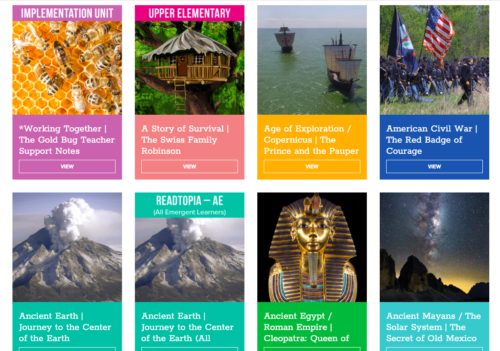
Reading Avenue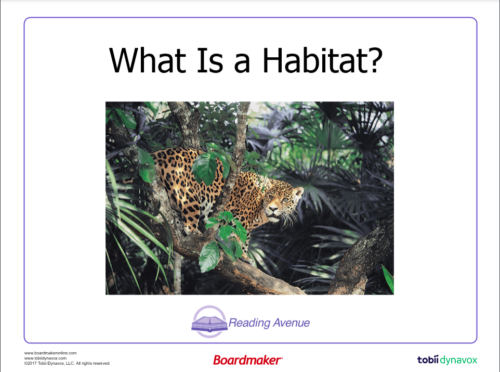
Tarheel Reader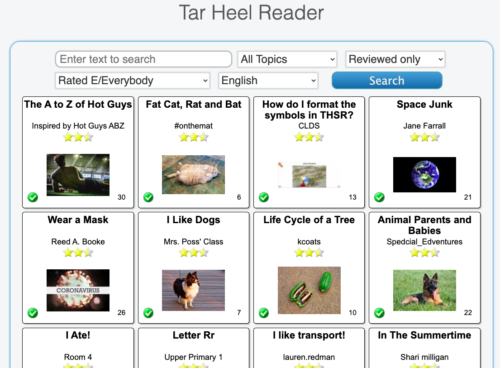
Predictable Chart Writing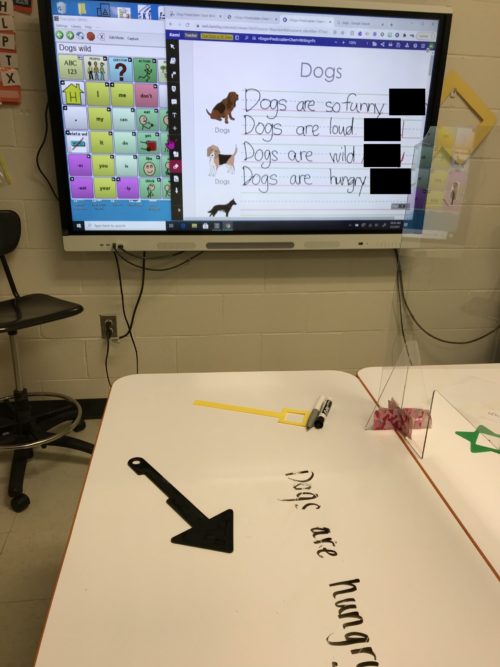
Does this mean that there cannot be any overlap between student interests and instruction/therapy? That we should never use student interests in our therapy and instruction? No! When we are working with emergent communicators and emergent readers, using student interests can be the foundation of fostering a love for reading and reasons to communicate. If we remember that at the heart of communication is connection, we can see the importance of valuing the interests of others. Part of respecting our students as individuals means respecting their current interests. It also means respecting that their interests may change over time, and to provide them with variation so that they are able to choose what they like. If we are consistently integrating the same themes because we know that is what the student likes, then we are not giving them a choice.
For example: Student who loves the song “The Wheels on the Bus.” Upon further observation and discussion, we learn that the student loves buses and is always very excited to see his bus driver.
- Make a book about transportation with the student. They could choose photos of different types of transportation and put them into a book that they create. If the student is an emergent reader, an alphabet book can be created with different words associated with transportation. It could also be done as a classroom using Predictable Chart Writing using a sentence stem such as “The ______ goes fast” or “I like ____.”
- Choose an adapted novel that integrates the topic of transportation, such as The Tuskeegee Airmen (Readtopia)
- Look into school jobs for the student related to buses. Can they help with bus duty? Announce the arrival of buses over the intercom? Think about how communication can be embedded into this activity to provide meaningful opportunities for interaction.
- Have the student interview the bus driver as part of an occupations project. If the student is an emergent communicator, this would be a great time to use co-planned social scripts.
These examples a) look closely at the why the student finds the topic interesting, b) provide opportunities to introduce age-respectful content with student choice c) infuse literacy and other functional skills, and d) focus on human connection as the goal of communication.
Tarheel Reader
Curriculum for high school students also needs to be functional. If we return to the definition above, we see the words practical and useful. Activities of daily living can be very functional. They also can be repetitive, boring, and or not useful. We need to look at the individual when determining if a goal is functional.
There are goals that are always functional no matter the age: those which incorporate comprehensive literacy instruction and spontaneous and novel utterance generation (SNUG). SNUG cannot be attained without literacy. It is also important to examine the areas of communicative competence (linguistic, operational, social, and strategic) in the development of goals related to the transition plan, as the integration of these skills become more important as students near adulthood.
Resources (Click on titles for more information)
- Literacy for All In Conversation with Dr. Caroline Musselwhite
- Comprehensive Literacy for All
- Tarheel Shared Reader Professional Development Modules
- Project Core Modules
About the Series Author
Ashley Larisey is an SLP at Community High School District 218 in Oak Lawn, Illinois. She is also an Adjunct Clinical Supervisor and Instructor at Saint Xavier University. Ashley shares AAC content on Instagram at @mrs.larisey.
You can learn more from Ashley here and read the first post in the AAC in Secondary School here.
Filed under: Featured Posts, PrAACtical Thinking
Tagged With: education, school, teens
This post was written by Carole Zangari

